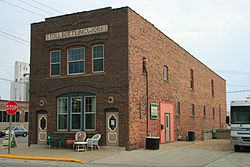Boonesboro, Iowa
| Boone, Iowa | |
|---|---|

Stoll Bottling Works Building in Boone
|
|
 Location of Boone, Iowa |
|
| Coordinates: 42°3′40″N 93°53′10″W / 42.06111°N 93.88611°WCoordinates: 42°3′40″N 93°53′10″W / 42.06111°N 93.88611°W | |
| Country | USA |
| State |
|
| County | Boone |
| Township | Des Moines |
| Incorporated | 1849 |
| Government | |
| • Mayor | John Slight |
| Area | |
| • Total | 9.02 sq mi (23.36 km2) |
| • Land | 9.02 sq mi (23.36 km2) |
| • Water | 0 sq mi (0 km2) |
| Elevation | 1,135 ft (346 m) |
| Population (2010) | |
| • Total | 12,661 |
| • Estimate (2012) | 12,546 |
| • Density | 1,403.7/sq mi (542.0/km2) |
| Demonym(s) | Booninites |
| Time zone | Central (CST) (UTC-6) |
| • Summer (DST) | CDT (UTC-5) |
| ZIP codes | 50036-50037 |
| Area code(s) | 515 |
| FIPS code | 19-07480 |
| GNIS feature ID | 0454753 |
| Website | www.boonegov.com |
Boone (/ˈbuːn/ BOON) is a city in Des Moines Township, and county seat of Boone County, Iowa, United States. It is the principal city of the Boone, Iowa Micropolitan Statistical Area, which encompasses all of Boone County. This micropolitan statistical area, along with the Ames, Iowa Metropolitan Statistical Area comprise the larger Ames-Boone, Iowa Combined Statistical Area. The population of the city was 12,661 at the 2010 census.
Coal mining played an important part in the early history of the Boone area. Local blacksmiths were already mining coal from the banks of Honey Creek south of what became Boone in 1849.
Boone was platted as a town in 1865 by John Insley Blair. It was incorporated the following year, when the Chicago and North Western Transportation Company railroad station was built there. The town was originally named "Montana"; it was renamed to Boone in 1871. The nearby town of Boonesboro was also chartered in 1866; Boonseboro was annexed to Boone in 1887.
Commercial mining was spurred by the arrival of the railroad. In 1867, Canfield and Taylor opened a mine just west of town. Their mine shaft was 242 feet deep, and they hauled coal to the railroad by wagon. In 1874, a railroad spur was built to the mine. This mine was taken over by the railroad, and operated for 30 years. There were coal seams in the Boone area; the upper vein, about 3 feet thick, was always worked using longwall mining, while the lower vein was always mined using room and pillar mining. In 1912, United Mine Workers Local 869 in Boone had 554 members, close to 10% of the population at the time.
...
Wikipedia
